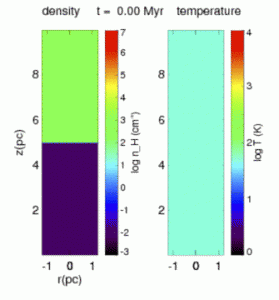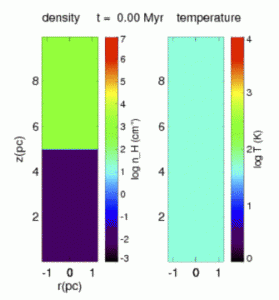Project Descriptions
Chemical evolution of the interstellar medium is tightly coupled with its hydrodynamical and thermal evolution. The rates of chemical reactions depend sensitively on the density and temperature of the gas. Molecular cloud cores with different magnetic field strengths, angular momenta, and initial density profiles have different hydrodynamical evolutions during gravitational collapse. The observed variations of chemical properties might be caused by their respective hydrodynamical evolution inside each of the cores. Hydrochemical modeling of the star formation process may help with the insights into the origins of the observed differences. Our efforts on chemistry in star formation processes branch out into the following two major directions.
The Suite: Kinetic Modules (KM)
Kinetic Modules (KM) is a suite of codes for astrophysical hydrochemical simulations including large chemical networks, radiation, fluid dynamics, and self-gravity.
- General properties of a 1D (spherically symmetric) dynamical-chemical evolution model

- Singular Isothermal Sphere (SIS) without UV irradiation, density (left) and on-axis abundance (right) [Please click for animations]
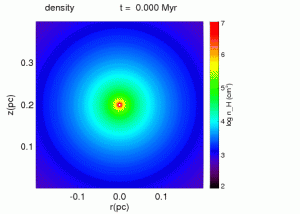
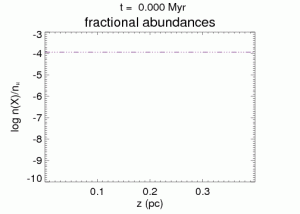
- Density and temperature evolution in a photo-dominated region (PDR), with (left) and without (right) hydrodynamic evolution [Please click for animations]
- A two-dimensional hydro-chemical hybrid code, KM2, is constructed to deal with astrophysical problems that would require coupled hydrodynamical and chemical evolution. The code assumes axisymmetry in the cylindrical coordinate system and consists of two modules: a hydrodynamics module and a chemistry module. The hydrodynamics module solves hydrodynamics using a Godunov-type finite volume scheme and treats included chemical species as passively advected scalars. The chemistry module implicitly solves non-equilibrium chemistry and change of the energy due to thermal processes with the transfer of external ultraviolet radiation. Self-shielding effects on photodissociation of CO and H2 are included.
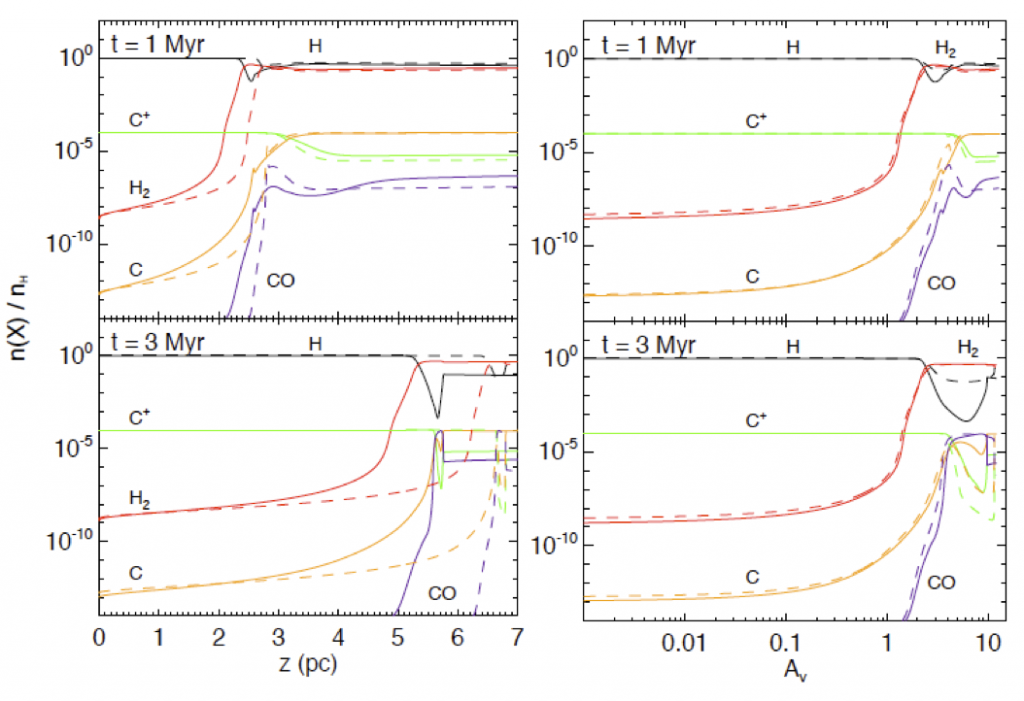
- Recent updates include the usage of sparse-matrix techniques to speed up the calculation of the chemical networks.
Science Results
Numerical simulations (KM1) were conducted to calculate the density and temperature profiles of a magnetized bright-rimmed cloud irradiated by far-ultraviolet (FUV) photons from the nearby high-mass star. The results were compared with the Nobeyama observation of a bright-rimmed cloud SFO 22 in Orion.
Related Publications
- Motoyama K; Krasnopolsky R; Shang H; Aida K; Sakane E, “An Efficient Algorithm for Astrochemical Systems Using Stoichiometry Matrices”, ApJS: 270(2), 19, Jan 17, 2024 [SCI] ( ADS | Fulltext )
- Motoyama K; Morata O; Shang H; Krasnopolsky R; Hasegawa T, “A hydrochemical hybrid code for astrophysical problems. I. Code verification and benchmarks for a Photon-Dominated Region (PDR)”, ApJ: 808(1), 46, Jul 20, 2015 [SCI] ( ADS | Fulltext )
- Motoyama K; Umemoto T; Shang H; Hasegawa T, “Effects of Magnetic Field and Far-ultraviolet Radiation on the Structures of Bright-rimmed Clouds”, ApJ: 766(1), 50, Mar 20, 2013 [SCI] ( ADS | Fulltext )


